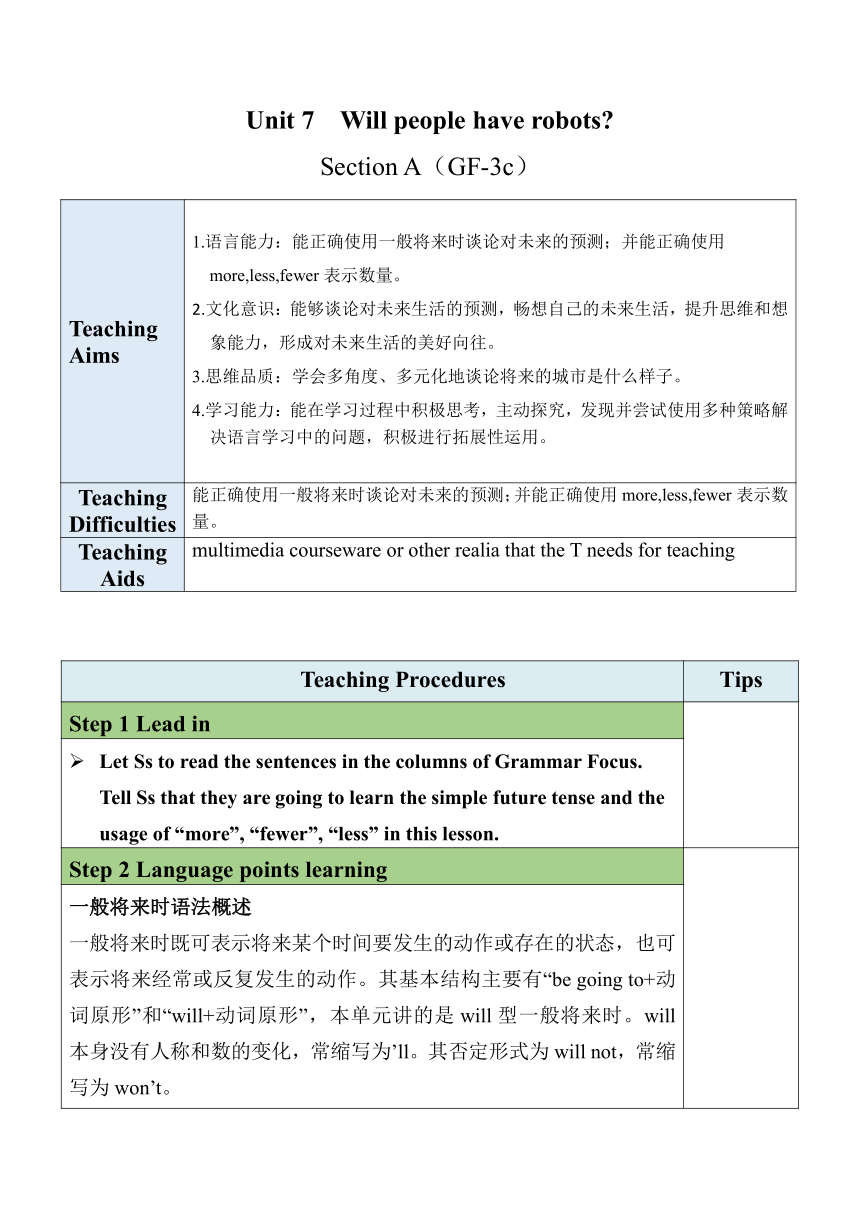
Unit 7 Will people have robots Section A(GF-3c) Teaching Aims 1.语言能力:能正确使用一般将来时谈论对未来的预测;并能正确使用more,less,fewer表示数量。 2.文化意识:能够谈论对未来生活的预测,畅想自己的未来生活,提升思维和想象能力,形成对未来生活的美好向往。 3.思维品质:学会多角度、多元化地谈论将来的城市是什么样子。 4.学习能力:能在学习过程中积极思考,主动探究,发现并尝试使用多种策略解决语言学习中的问题,积极进行拓展性运用。 Teaching Difficulties 能正确使用一般将来时谈论对未来的预测;并能正确使用more,less,fewer表示数量。 Teaching Aids multimedia courseware or other realia that the T needs for teaching Teaching Procedures Tips Step 1 Lead in Let Ss to read the sentences in the columns of Grammar Focus. Tell Ss that they are going to learn the simple future tense and the usage of “more”, “fewer”, “less” in this lesson. Step 2 Language points learning 一般将来时语法概述 一般将来时既可表示将来某个时间要发生的动作或存在的状态,也可表示将来经常或反复发生的动作。其基本结构主要有“be going to+动词原形”和“will+动词原形”,本单元讲的是will型一般将来时。will本身没有人称和数的变化,常缩写为’ll。其否定形式为will not,常缩写为won’t。 一般将来时的句式结构 肯定句:主语+will+动词原形+其他 否定句:主语+won’t+动词原形+其他 一般疑问句及其肯定、否定回答:Will+主语+动词原形+其他? 肯定回答:Yes, 主语+will. 否定回答: No, 主语+won’t. 特殊疑问句:特殊疑问词(短语)+will+ 主语+动词原形+其他? 一般将来时的用法 will+动词原形”常与表示将来的时间状语连用,如tomorrow, the day after tomorrow, next year , in the future等。 there be句型的一般将来时结构 there be句型的一般将来时结构: there will be; 其否定形式是在will后直接加not; 其一般疑问句形式是直接把will提到句首; 肯定回答为“ Yes, there will.”; 否定回答为:“No, there won’t.”。 will和be going to 的区别 be going to往往表示将要发生的动作或安排,特别是打算、计划、决定要做的事。 一般将来时(will)常用来客观陈述将来某个时间要发生的动作或存在的状态(will作为情态动词常表意愿)。 more / fewer / less的用法 more意思是“更多的”,是many和much的比较级,后面跟可数名词复数或不可数名词。 less的意思是“更少的”,是little的比较级,后只跟不可数名词。 fewer的意思是“更少的”,是few的比较级,后只跟可数名词复数。 Step 3 Presentation & Practice 3a Ask Ss to fill in the blanks with more, less or fewer. Answers: 1. less, more 2. more, more 3. fewer, more 4. more, more 5. less, more (or “more”, “fewer”) 3b Ask Ss to complete the predictions with what they think will happen in the future. Answers will vary. 3c Divide Ss into groups of four. Ask each group to draw a picture of what they think a city in the future will be like. Then describe it to the class. T can make activity 3c more challenging by asking Ss to include 10 different predictions in their pictures without labeling them. After Ss have finished their pictures, instruct Ss to work in pairs and exchange pictures. Each of the Ss in the pair has to find the 10 predictions in the picture. (Tip: T can use the example on PPT P17 as an example.) Step 4 Summary & Homework Summary A ... ...
~~ 您好,已阅读到文档的结尾了 ~~

